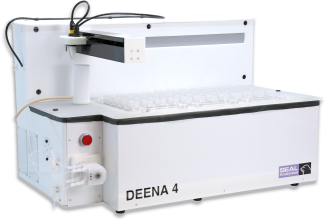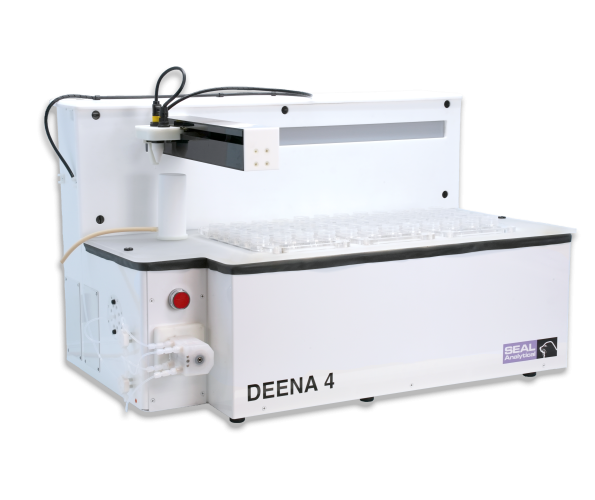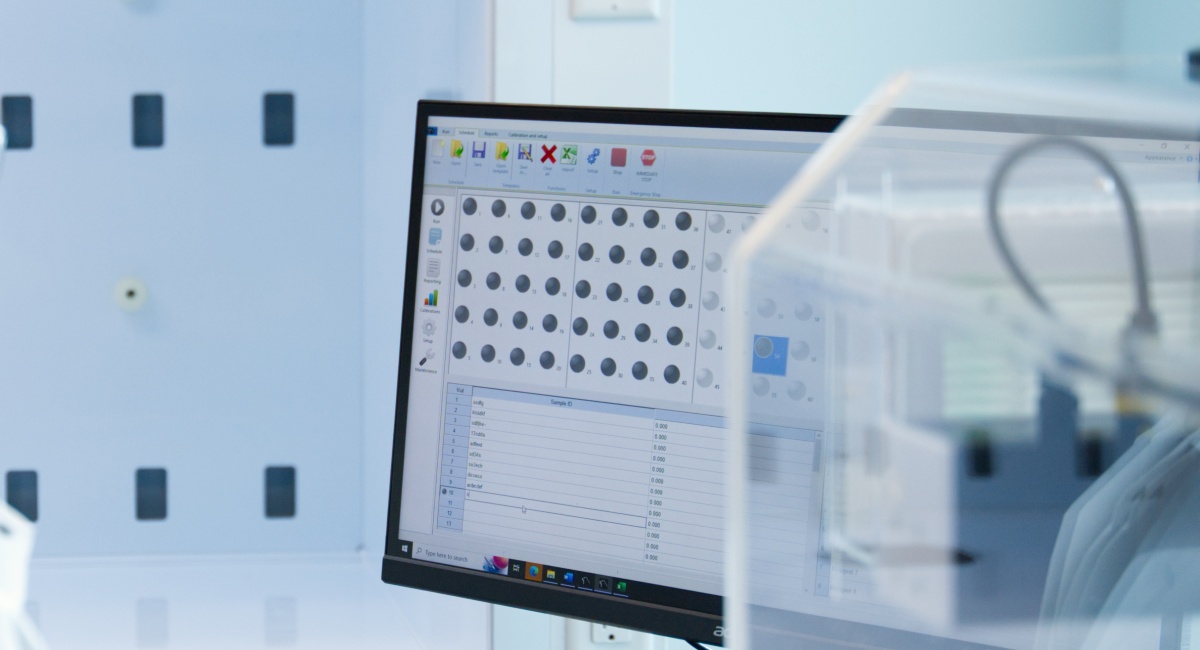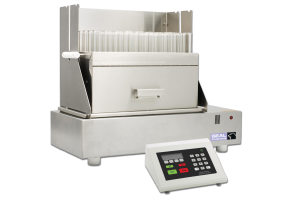DEENA 4 Automated Digestion System
Automated metals digestion and sample preparation

Safe, Reliable Sample Preparation and Metals Digestion
Ideal for metals, mercury, total phosphorous (TP) and total nitrogen (TN) digestions, the DEENA 4 system fully automates the sample digestion process. Bringing increased hardware options and a higher-resolution ultrasonic sensor than the preceding DEENA II, it quickly and accurately dispenses small volumes of reagents into sample tubes, mixes thoroughly, applies heat, and then fills to volume after digestion is complete. This automation improves throughput and repeatability while helping to safeguard against human error.
With an optional self-contained HEPA-filtered fume hood, the DEENA can bring automated digestion even to lab’s with little or no fume hood bench space. Connect the exhaust port to your existing duct work to bring digestion safely to any space in your laboratory.
View the full specifications
Download the brochureWhy select the DEENA 4?
Automation
- Completely automated digestion process including reagent addition, mixing, heating, and reconstitution
- High-resolution ultrasonic detection for precision dispense during reconstitution
- Options for a syringe module or dedicated pumps in addition to default 8-way valve pump for reagent dispense
- Precision temperature control in a graphite block for digestions at up to 200 degrees C
Compliance
- Eliminates human error, ensuring identical sample prep and digestion for every vial
- Improved lab safety with elimination of manually dispensing acids and dangerous reagents
- No direct contact with sample or vial to prevent cross contamination
- Detailed digestion logs available in software for quality assurance and auditing
Efficiency
- The DEENA’s electronics are securely protected from acid fumes inside durable casing
- Programmable start times for overnight digestions, ensuring samples are ready at the start of the day
- Various tube sizes and materials for different methods and digestion temperatures
- Intuitive software with streamlined operation
Support
- Visual manuals and descriptive checklists
- Immediate support available from SEAL chemists via email, phone, screenshare, or video call
- In-depth training during installation
Highlights of the DEENA 4

.jpg?resolution=595x500&quality=95)
.jpg?resolution=595x500&quality=95)

.jpg?resolution=595x500&quality=95)
(1).jpg?resolution=595x500&quality=95)
Free up valuable fume hood space with the optional self-contained HEPA filtered fume hood. Connecting directly to your existing duct work, this allows the DEENA to operate safely on your laboratory bench tops or other locations.
The DEENA 4 uses a peristaltic pump with an 8-way valve for default reagent dispense. Optional individually-calibrated, dedicated pumps are also available, as well as a syringe module for the highest precision and sample spiking.
15 mL (96 positions), 50 mL (60 positions), and 100 mL (36 positions) vial options answer all volume needs. Flat-bottom or conical-bottom polypropylene vials handle digestions up to 135 degrees C, while glass or PTFE vials handle digestions up to 200 degrees C.
Intuitive, user-friendly software allows for simple addition and adjustment of each digestion step and fully customizable method programs.
Experience trouble-free mechanical operation with SEAL’s signature encoded motors on the DEENA 4. These motors provide real-time feedback and precision control to the system, ensuring greater accuracy in movement and positioning.
How the DEENA 4 Works
Step 1
Block Begins Warming at Pre-Programmed Time
Block begins warming at pre-programmed time to ensure quick heating to target temperature during digestion program.
Step 2
Digestion program is selected or built in the software
After creating a digestion programmed with adjustable digestion steps, or selecting a previously-created method, customized method programs are assigned to sample positions in the software.
Step 3
Digestion program begins with reagent dispense
After the program is started, the DEENA 4 flushes the dispense line with rinse water. While mixing by shaking the trays, the DEENA dispenses reagent into each sample vial, returning to the rinse station to flush the line with DI water before dispensing the next reagent. After the last reagent is added, additional mixing takes place if programmed.
Step 4
Samples are brought to temperature
Sample vials descend into the graphite block as heating begins. Temperatures are tracked and recorded in the DEENA software for quality assurance. Reflux caps can be added, or 20-position reflux plates can be placed on top of vials for streamlined placement and cleaning.
Step 5
Cool down and reconstitution
After digestion time has completed, sample vials raise out of the digestion block to begin cooling. A high-resolution ultrasonic sensor monitors volume as samples are reconstituted with desired solution.
Step 6
Samples ready for analysis
After reconstitution and programmed cooling time, samples are ready for capping and storage or analysis.
.jpg?resolution=1240x450&quality=95)
.jpg?resolution=1240x450&quality=95)
.jpg?resolution=1240x450&quality=95)
.jpg?resolution=1240x450&quality=95)
.jpg?resolution=1240x450&quality=95)
.jpg?resolution=1240x450&quality=95)

Get Digesting with DEENA Software
DEENA’s intuitive software is designed for simple navigation with user-friendly icons and menus. Methods are completely customizable with easy to understand commands, and several commonly used methods come pre-loaded in the software. Each instrument command is time-stamped on reports and will satisfy any audit requirements. A detailed log can be printed or exported for tracking every sample throughout the run. Real time functions allow the user to track sample temperature and insert comments while the run is in progress. Runs on Windows 7® through Windows 11®.
DEENA 4 Automated Digestion Block Methods
The DEENA 4 can be programmed to meet your lab’s digestion needs to prep samples for a wide-range of methods. The system is commonly used for digestion before a variety of analyses including metals and mercury analysis. Contact our team for more details on what the DEENA 4 can do for your lab!
| EPA Method Number | EPA Method Name |
| 3005 | Acid Digestion of Waters for Total Recoverable or Dissolved Metals for Analysis by Flame Atomic Absorption (FLAA) or Inductively Coupled Plasma (ICP) Spectroscopy |
| 3010 | Acid Digestion of Aqueous Samples and Extracts for Total Metals for Analysis by Flame Atomic Absorption (FLAA) or Inductively Coupled Plasma (ICP) Spectroscopy |
| 3050A | Acid Digestion of Sediments, Sludges, and Soils |
| 3050B | Acid Digestion of Sediments, Sludges, and Soils |
| 200.2 | Sample Preparation Procedure for Spectrochemical Determination of Total Recoverable Elements |
| 200.7 | Determination of Metals and Trace Elements in Water and Wastes by Inductively Coupled Plasma-Atomic Emission Spectrometry |
| 200.8 | Determination of Trace Elements in Waters and Wastes by Inductively Coupled Plasma-Mass Spectrometry |
| 7470A | Mercury in Liquid Waste (Cold-Vapor Technique) |
| 7471A | Mercury in Soild or Semisolid Waste (Cold-Vapor Technique) |
| 245.1 | Determination of Mercury in Water by Cold Vapor Atomic Absorption Spectrometry |
| 1631 | Mercury in Water by Oxidation, Purge and Trap, and Cold Vapor Atomic Fluorescence Spectrometry |
| 245.7 | Mercury in Water by Cold Vapor Atomic Fluorescence Spectrometry |
Other models
Frequently Asked Questions
Below, we’ve listed a few frequently asked questions that will help you better understand our Digestion Systems. If you don’t find the answer you're looking for, please don't hesitate to contact our support team for further assistance.
As the digestion block simply follows the programmed steps based on your already approved digestion method, they typically do not require a separate approval to automate an existing approved method.
During any metals digestion, contamination is a concern. The DEENA 4 automated digestion system for trace metals digestion is built with a metal-free digestion zone to minimize the potential for metals contamination. The system utilizes a glass top, PTFE upper housing, and carbon fiber construction for the dispensing arm, along with a graphite digestion block. We take additional contamination-eliminating steps by requiring proper ventilation, removing fumes during the digestion.
The DEENA requires 80 CFM of airflow ventilation if placed in a fume hood. SEAL offers a stand-alone fume hood attachment that connects directly to the top of the DEENA to integrate with existing duct work, which allows for the flexibility to place the DEENA anywhere in the lab, freeing up valuable fume hood space. This stand-alone fume hood is sealed with a foam gasket and HEPA filtration.
Related articles
.jpg?resolution=428x267&quality=95)
.jpg?resolution=428x267&quality=95)
.png?resolution=428x267&quality=95)
Ready to get started on your next digestion system?
Request Information
Fill out the form below to request information about our products and services.

.jpg?resolution=1200x650&quality=95)
(1).png?resolution=290x200&quality=95)
.png?resolution=290x200&quality=95)
(1).png?resolution=290x200&quality=95)
